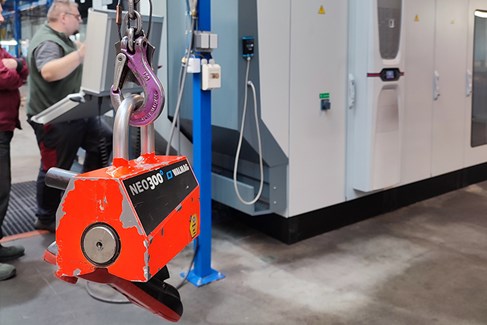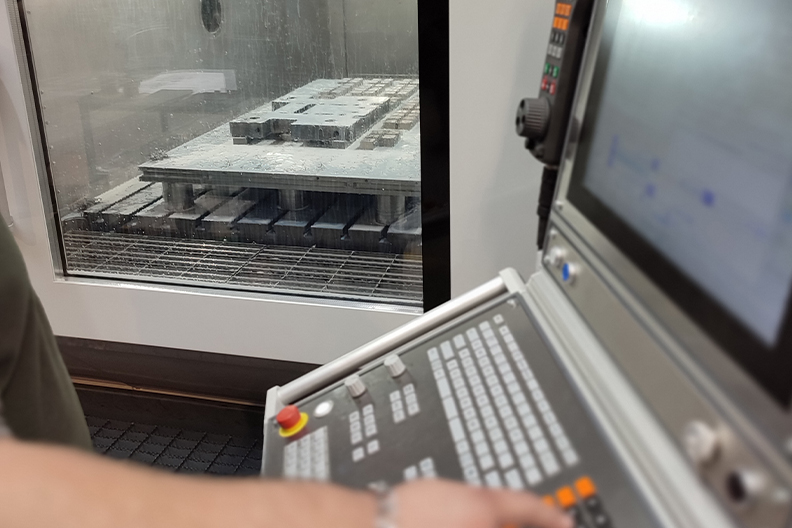
In many ways, magnetic chucks and lifting magnets are safer than handling workpieces manually. You just need to remember a few safety rules. What to look out for when working with magnets? How can magnets make your job easier? Read on.
General Safety Rules
General Health & Safety rules for lifting heavy objects and clamping workpieces have to be respected at all times — and working with magnets is no exception. When lifting heavy objects, always follow the general rules for lifting heavy loads (maximal allowed weight in case you need to lift load manually). Wear prescribed helmets and other safety equipment and never exceed the nominal load capacity of a lifting magnet.
On the same note — obey general Health & Safety rules when clamping workpieces for machining operations. Use mandatory safety equipment (goggles, face shields, protective gloves) — doesn’t matter whether you clamp workpieces for machining mechanically or by magnets. Safety equipment provides necessary protection against accidents. Such as a swarf piercing an eye when working on an old lathe machine, or hands burned by a workpiece still hot from machining.
Safety Rules for Lifting Magnets
Without lifting magnets, operators need to tie the lifted load to so-called C-hooks. Tying load by hand always increases the risk of human error — a tied load might get loose, with fatal consequences. Lifting by magnets is safer as it doesn’t require personnel standing right under lifted load.
Lifting objects by magnets is easy and safe. The operator places the lifting magnet on the lifted load, and activates the magnet with a switch lever. That’s it. The only thing to consider is putting the magnet right in the centre of the lifted object. This is essential especially when lifting longer objects — a long load might slide sideways when attached to the lifting magnet by its side (due to the force of friction).
 Safety Rules for Magnetic Chucks
Safety Rules for Magnetic Chucks
Magnetic chucks are subject to multiple forces during machining, the friction force being just one of them — read our article about various physical forces affecting magnets. Therefore, the shape of a magnetic chuck matters a lot. Bear that in mind when choosing yours — we’re always happy to consult your choice. Or even design and produce a made-to-measure magnetic chuck for you.
Clamping workpieces by magnets is much safer than manual clamping with a wisely chosen magnetic chuck and with operators respecting general Health & Safety rules. Every task that is not automated bears a higher risk of human error, such as the clamp not being tight enough. That never happens with a magnet. In addition, workpieces clamped by magnetic chucks are accessible from 5 sides — and don’t need to be re-clamped multiple times (often the case with manual clamping).
Learn more about operating magnets here.
Specifics of Permanent Magnets
Permanent magnets have certain specifics you need to pay attention to when using them:
- their magnetic core is quite fragile,
- their magnetic field cannot be completely switched off — they’re magnetic at all times.
Most often, a permanent magnetic core is used in lifting magnets. As a user, you don’t need to be concerned about the fragility of the magnetic core — it’s firmly set in the magnetic device which is solid enough to withstand any collision. In Walmag, we pay special attention to the construction of our magnets being sturdy and long-lasting.
Specifics of Extra Strong Magnets
With larger magnets, bear in mind that their powerful magnetic field can affect the functioning of some electronic devices or damage magnetic data carriers. Follow these safety precautions when using strong magnets:
- Operating strong magnets is not safe for people using electronic devices to support their vital functions (e.g., a pacemaker or an insulin pump).
- Strong magnetic field affects the functionality of some measuring devices. Always place strong magnets in safe distance. Pay special attention to permanent magnets (magnetic even when not active). Find out about safe distance in the magnet’s user manual or consult the magnet’s manufacturer.
- Never place magnetic data carriers in the vicinity of active magnets. Be careful, especially with debit or credit cards (the older type with a magnetic stripe).
Not sure what’s the difference between permanent, electropermanent and electromagnets? Read our take on it.
Magnetic Field and Health
Can long-term subjection to a magnetic field harm your health? Absolutely not! There are no proven harmful effects of a magnetic field to a human body. Some people would even argue that subjection to a magnetic field is beneficial (with magnetotherapy recognised as a branch of physiotherapy).
Magnetic chucks and lifting magnets make any production safer, faster, and more effective. Read our comparison of magnetic chucks vs manual clamping here or ask us directly. We’re happy to explain the benefits of magnets, and even lend you a magnetic chuck or a lifting magnet to try out.